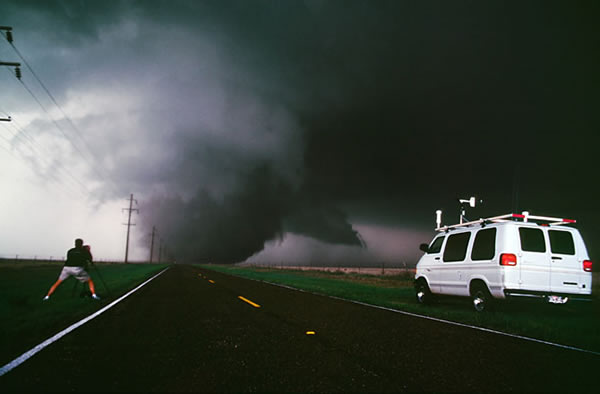Storm Chasers: Are There Too Many?
This tornado outside the sleepy Texas town of Happy killed two people and destroyed a church as it churned west of the town. Chasers Eric Nguyen and Dave Fick (pictured) captured the large monster from the north.
Storm chasing has been going on for decades, but the deaths of three storm chasers in the widest tornado in history on May 31 in El Reno, Oklahoma, has reignited a debate among meteorologists over who is really chasing storms for science that benefits society and who is just trying to get footage they can sell to media outlets or providing storm chasing tourism services.
"When I did it in the 1970s and 1980s, we were the only ones out there," recalls meteorologist Dan Satterfield, who was born and in Oklahoma and chased storms as a meteorology student at the University of Oklahoma. He is now a television weatherman for CBS affiliate WBOC TV in Salisbury, MD and a science blogger for the American Geophysical Union.
Giant Tornado Hits Oklahoma DCI
Now, with sometimes as many as 80 storm chaser cars driving toward the path of a tornado, Satterfield asks if we have overreached the danger limit. "For three or four years now we've been saying that someone is going to get killed."
And what happened on Friday, he said, exactly fit the worst-case scenario: A very unusual and powerful tornado, with an unprecedented 2.6-mile-wide funnel, that appeared suddenly and behaved erratically.
Other meteorologists, however, are defending all but the most clearly irresponsible storm chasers.
“How did we learn Doppler radar really worked? 'Ground truth' – having someone on the ground confirm or deny that the swirl of air shown on the radar was really a tornado," asserted Mike Smith, another meteorologist blogger and author of Warnings: The True Story of How Science Tamed the Weather. "And, more often than not, that someone was a storm chaser or storm spotter.”
Smith, who has been chasing storms for four-decades, argues that there is still a genuine need for storm chasers because there are still too many false alarms about tornado warnings.
"We have to lower the number of false alarms so the public will have more confidence in the warning system," argued Smith. "And, part of the key to these further improvements will be storm chasing.”
Also important to note, said Smith, is that in 41 years of organized storm chasing, these are the first deaths. That, itself is a testament to the care practiced by storm chasers, he added.
Still, "if they speed, run red lights, or make illegal turns they should be ticketed like anyone else," Smith asserted. "But, most chasers are motivated to get vital data to improve future warnings, work with the existing warning system, or see the majesty of Mother Nature for themselves – in much the same way others climb Everest. People come from all over the world as storm tourists to go with tour companies to see Great Plains thunderstorms in their majesty in the same way people tour Yellowstone or Yosemite."
Satterfield, for his part, is less supportive of all the non-scientific storm chasing.
"I really think that all these chasers are getting in the way of the science," Satterfield told Discovery News. "The news media has really overplayed the value of storm chasers."
Satterfield, after thinking about the tragedy for a few days, decided to air his views on his blog and concluded: "I hesitate to criticize severe weather coverage because I know how difficult it is to do. I’ve been subjected to criticism over past events as well. That said, the OKC media needs to take a hard look at how they covered these storms. A hard look."(Jun 6, 2013 09:40 AM ET // by Larry O'Hanlon)












